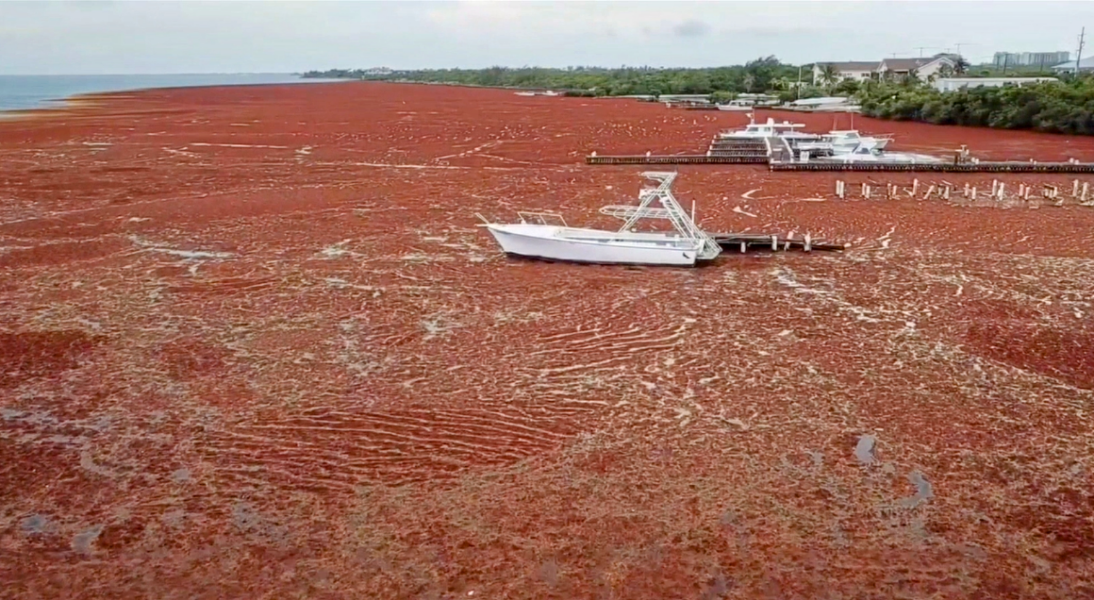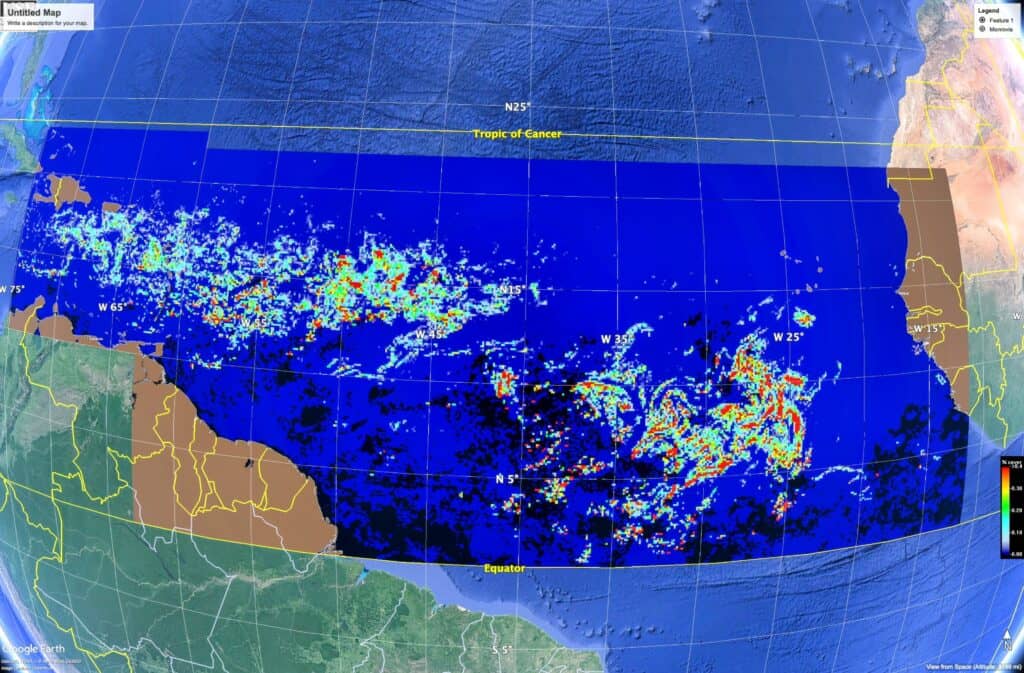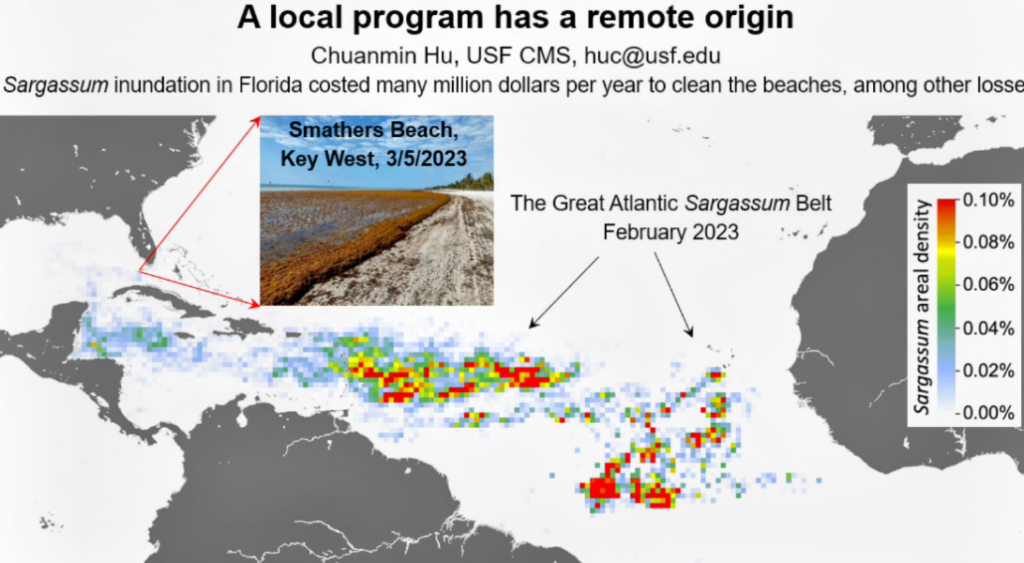Thrive
USFSP researchers track seaweed mass visible from space

For the past seven years, national agencies have tasked researchers at the University of South Florida St. Petersburg with tracking an ever-growing accumulation of what most people refer to as seaweed.
Dr. Chuanmin Hu, a professor at the College of Marine Science, takes issue with most publications calling the floating sargassum bloom a “blob.” He said it is a belt, and while it now stretches from the coast of Africa to the Caribbean, it is not continuous.
That said, the mass is roughly 5,000 miles long – twice the length of the U.S. – and visible from space. What began as an anomaly in 2011 is now breaking size records.
“We really want to understand why this is the new normal,” Hu said. “And what are the causes and what are the consequences of this new normal? Before 2011, there was almost no seaweed in the tropical Atlantic or Caribbean Sea.”

A USF College of Marine Science satellite-based map from March 7-13 shows the expansive bloom approaching Florida. Photo: Dr. Chuanmin Hu, USF.
The “Great Atlantic Sargassum Belt” is actually the world’s largest brown algae bloom. The mass drifts between the coast of Africa and the Gulf of Mexico, providing a rich marine habitat while absorbing carbon dioxide.
However, once the seaweed reaches the shore, the bloom degrades water quality, emits a noxious odor, attracts insects and bacteria and repels tourists. That subsequently impacts local economies.
In addition, local governments must clean up potentially tons of rotting mess. Hu and his colleagues at USF St. Petersburg’s Optical Oceanography Laboratory track and study sargassum blooms using satellites and fieldwork.
NASA and the National Oceanographic and Atmospheric Agency (NOAA) fund their efforts, and he believes the local facility is the preeminent source for sargassum data.
Hu noted the mass could affect shipping routes and trap smaller boats by tangling around propellers and clogging intake valves. He stressed the importance of boaters and captains paying attention to where they navigate and said that once they are in the mass, “it’s really hard to get out.”
“A continuous, single mat could be several miles long and 100 meters wide,” Hu added. “You don’t want to get inside if you drive a small boat.”
Docked boats in affected areas don’t fare much better, although he repeatedly stressed that Caribbean countries feel the brunt of the blooms’ impacts. Once near shore, the algae can devastate coast ecosystems, suffocate coral, decrease air quality and impact local infrastructure.
Despite many reports, however, Hu doesn’t anticipate the sargassum mass to significantly affect the Tampa Bay area, or most of Florida, for that matter.
He said beaches in the panhandle and south of Naples could experience some impacts, with more along the Florida Keys. Pinellas County is “totally fine,” he added, save for typical summer seaweed clumps.
“Local managers are prepared to remove the seaweed in time every day before it decomposes,” Hu explained. “It’s (the cleanup) not free; it will cause problems. But it’s nothing like major hurricanes or even red tides.
“So, I don’t want to send out a wrong signal – ‘oh, there’s a huge blob coming to Florida.’ No, that’s not the case.”

A USF St. Petersburg Optical Oceanography Laboratory slide showing impacts to Key West.
However, Brian LaPointe, a research professor at Florida Atlantic University’s Harbor Branch Oceanographic Institute, told NBC News that “what we’re seeing in the satellite imagery does not bode well for a clean beach year. It’s incredible.”
The College of Marine Science provides that satellite imagery.
Lapointe also explained that the hydrogen sulfide released by rotting sargassum could cause respiratory problems for anyone nearby. Earlier this week, officials in Mexico warned of seaweed accumulations reaching three feet deep in some areas.
The scientific unknowns complicate matters. Hu relayed there were only a few relatively small, intermittent clumps of sargassum in the Atlantic until 2011.
While the belt began forming 12 years ago, its size didn’t raise many eyebrows in the scientific community. Everything changed, Hu said, five years ago.
The mass began growing exponentially, setting records in 2018 and 2022. This year’s bloom is the largest in history for March.
“Our fear was this year may set up a new record, but we are not there yet,” Hu said. “Typically, the seaweed reaches a maximum in June or July.”

USF graduate student Sam Brunson collects sargassum from the Gulf. Photo provided.
He added that the mass increases annually on average and credited climate change and human influence for its explosive growth. Hu called it a complex issue with many factors – like the harmful algal blooms that cause red tide.
More questions than answers remain, underscoring the need for the College of Marine Science’s research.
Although he stressed sargassum is typically nontoxic, Hu noted that “too much of a good thing becomes bad.” When a seaweed blanket forms, it keeps light from penetrating through the water’s surface.
Marine life depends on light, and dead plants and animals absorb critical oxygen as they rot. He said that is “a problem from all angles.”
“That’s pretty rare,” Hu added. “It’s a double-sided sword, depending on the location, timing and the amount.”








Jim Sweeney
March 24, 2023at9:05 pm
Nice to have balanced reporting on this algae bloom……we don’t have to run for the hills. Keep doing research on this topic ….much appreciated
Renee
March 22, 2023at2:14 pm
Doesnt anyone actually read? The scientists have already said that the seaweed is toxic once it gets to shore, I saw a picture of a student scooping up the seaweed with a net, WHY ISNT ANYONE DOING THIS WITH A HUGE NET?
Robert Garnett
March 22, 2023at8:49 am
Why study it and complain while you watched it grow. Its a cost issue on cleanup now, as oppose to a study issue. How can you watch and study something for so long that it grows to 5000 miles and you are unaware its a problem. So your study failed and costs now. Like the trash pile float it was studied got bigger and costs now that it is as big as it is its a problem. If your study paid you i think its your problem you let get out of hand just to see what it does
Chris Macaulay
March 21, 2023at11:32 am
IT NEEDS TO ANCHORED SOMEHOW IN A OUT OF THE WAY SPOT AS A PERMANENT FISH HANGOUT
Mary Hadalittlelamb
March 21, 2023at10:30 am
I understand the importance of doing studies so as to learn why this is happening, however its careless & neglectful to not have reported this sooner… Furthermore my opinion only of course, is that the funding should now be made to pay for the huge financial burden & hardship it may pose…
Marcus Allen
March 21, 2023at9:26 am
The readers are getting more intelligent 🧠 and once again nature is show how lazy and ignorant we have become. ✍🏼
James
March 21, 2023at8:12 am
Living on the gulf coastline. That’s one BIG stink and mess out there. Need some kind of MEGA floating barrier like they use for oil spills to detour the seaweeds back around from the coastlines.
Jonathan Jackson
March 20, 2023at10:37 pm
You guys are crqzy. It is seaweed, burning it, spreading it on landfill, why do anything with it. Also it said it wouldn’t affect florida but it is still a problem , just not for florida/USA. Qgain it growing, and it qasntbthere 11 years ago. Maybe address the problem instead of over thinking impractical solutions.
David Ochoa
March 20, 2023at9:09 pm
When iron sulfide is dumped into the oceans as part of ongoing, unacknowledged geoengineering operations, it mixes with acids and fertilizer chemicals already in the waters to produce hydrogen sulfide, which is the stench that accompanies these algae and seaweed blooms. They’re some of the only life that can live in waters deoxygenated by aquatic iron seeding for military atmospheric operations.
NONE OF THIS IS “NATURE”. Your militarized research institutions either won’t find a cause or will make up a cover story of fake science that no one will check to placate the uninformed. Wake up fellow humans.
April Steele
March 20, 2023at7:11 pm
Do not use Sargassum in cooking, Florida officials advise. It may contain amounts of heavy metals such as arsenic and cadmium.
I also read that In 2018, NASA satellites photographed an estimated 20 million tons of Sargassum that stretched 5,500 miles across the Atlantic Ocean. The weight was more than 200 fully loaded aircraft carriers.
That was in 2018. It’s been growing at an alarming rate since 2011 Can you imagine how big it has grown in the last 5 years? It should almost be doubled in size.
Dwayne
March 20, 2023at7:11 pm
Build a ship or throw out nets and harvest the stuff for food for animals and fertilizer
Oscar
March 20, 2023at7:01 pm
Any research being done for it to be useful in anything?
April Steele
March 20, 2023at6:37 pm
I just read an article in USA Today titled Sargassum, a smelly seaweed, may be coming soon to a Gulf beach near you. Here’s what to know.
Sargassum is classified as an Essential Fish Habitat by the National Oceanic and Atmospheric Administration. That gives the seaweed special protections, including how it is collected. It can’t be removed directly from water – it has to wash up on shore first.
It explains in greater detail the pros and cons of the “Blob” Hope this helps. It helped me tremendously 😁
The Keymaster
March 20, 2023at6:24 pm
Its hard to use for anything. Takes too much fresh water to rinse out and it’s full of arsenic and other heavy metals. Stop fertilizer runoff into the sea to fix this!!
Reggie H
March 20, 2023at6:06 pm
This is awesome fertilizer. Human beings must learn to utilize every natural gift our planet gives us and stop complaining! That seaweed is worth hundreds of millions of dollars. The Americas, Africa and Caribbean should harvest as much as we can.
Art Merkle
March 20, 2023at5:24 pm
Large sargassum clumps were definitely in the Atlantic prior to 2011. Working as a beach lifeguard at The Boca Ratón Hotel and Club’s Cabana Club in the summers of 1976 and 1977, we encountered tons of the weed. Every morning before guests arrived, George Wright and I raked and buried the sargassum that washed up overnight. Sometimes the weed was 2-4 feet wide and 2 feet deep. The 300 feet of beachfront was quite the workout to rake, dig a trench in the sand and bury the stuff. Not sure about offshore pods, but it sure was on the beach every morning.
Greg Smith
March 20, 2023at3:47 pm
Good article, except for one thing. How did it start? It’s coming from Africa. What are they doing, that is causing the bloom?Shouldn’t that be the main objective of the scientists? Find the sourse, and try to remedy it.
Tyce R
March 20, 2023at3:25 pm
Does anyone know if this mass is seen as light as land or dark like the ocean? Not only could it be good in the ways mentioned by others here we need a bit of reflection from the sun to help recover from the loss of ice caps. I still think a well made artificial landmass could be beneficial if the governments of the world could band together in its creation. It would be difficult and expensive but I mean it would be to help save the world from being even further past help than it already is so kinda worth it, no?
Ed Gannon
March 20, 2023at12:31 pm
Phosphogypsum, a byproduct waste of the current method of making phosphate fertilizer, high in phosphorus, is being disposed into oceans globally.
And the current phosphate fertilizers produced, Mono and Di Ammonium phosphate, although they are good effective fertilizers, they are water soluble leaching into our water resources globally. 10 parts nitrogen with 1 part phosphate equals algae blooms, called Phosphogeddon.
Check out
http://Www.PhoSul.com
Safe, effective phosphate fertilizer with non of the negative effects of current phosphate fertilizer technology.
Michelle
March 20, 2023at11:55 am
Reading about red tides, with potential causes, and what it needs to survive, ex food source, nutrients. What are the causes of increasing sargassum? Also, many are quick to blame cruise ship dumping, human waste and food waste, into deep waters. I’m sure that is not legal if that is truly the case. Anyone know what is the cruise ship industry’s legal requirements are for their holding tanks and where they actually are able to empty their wastes?
Cha Max
March 20, 2023at11:32 am
If it gets bigger and more stable we can build a freeway on it.
LLJones
March 20, 2023at9:34 am
This sounds like nature’s way of combating the increased carbon dioxide in the world. Less boats in the water will help w pollution as well. The world can correct itself if we let it do its thing and stop interfering and destroying our natural resources.
tont
March 20, 2023at9:25 am
or maybe the earth is responding to climate changes and this is part of healing itself? If you strip a piece of ground the first plants that grow are large areas of broadleaf to shade and protect the ground so the smaller, nutrient rich grasses can grown underneath.
It would be interesting if that were the case
Estella j cuellar
March 20, 2023at8:51 am
I see alot of positive comments ,great it is who will take the steps to go forward with doing the right action.Is this seaweed good for seaweed eaters?
Christina
March 20, 2023at8:44 am
It’s edible for people and livestock. Harvest it.
SuzyQ
March 20, 2023at8:12 am
It’s true that some kind of use for this algae must be found, but given that sargassum contains arsenic, fertilizer probably won’t be a use. In Mexico, some are experimenting with making bricks of it, but the gas must first be removed. It’s a tricky problem!
Matt
March 20, 2023at7:40 am
This can’t be used for fertilizer as it has too high of an arsenic content, but it’s a good thought…
Chris
March 20, 2023at7:15 am
I’ve read that the seaweed is high in arsenic so unfortunately not suitable to fertilize anything in the food chain.
Lyle Eckert
March 20, 2023at6:23 am
Habitat: Sargassum provides an important habitat for many marine organisms, such as fish, crabs, and shrimp, as well as juvenile sea turtles and other sea creatures.
Food source: Sargassum is an important food source for many marine organisms, including herbivorous fish, sea urchins, and marine mammals.
Carbon sequestration: Sargassum is able to sequester carbon dioxide from the atmosphere, helping to mitigate the effects of climate change.
Fertilizer: Sargassum can be used as a natural fertilizer for crops, as it contains high levels of nutrients such as nitrogen, phosphorus, and potassium.
Bioremediation: Sargassum can help to clean up polluted waters by absorbing heavy metals and other pollutants.
Economic benefits: Sargassum has commercial value and can be used in a variety of products, such as fertilizer, animal feed, and cosmetics.
Overall, Sargassum plays a vital role in the marine ecosystem and provides a range of benefits to both the environment and human society.
Joe Homer
March 20, 2023at5:17 am
Profit there from! Find out ways to benefit from harvest of this bloom.
Thomas mcarrhut
March 20, 2023at4:24 am
Had afriend who had a seaweed processibg plant in beaufirt nc used sargaso weed noaa shut him down for fear he might have taken to much
P jesseph
March 20, 2023at2:44 am
Could a fleet of huge ships collect and burn this?
Bradley l rumley
March 20, 2023at1:55 am
I imagine that most people don’t think about how the algae in one since could be a good thing. I think one way it could be good is that the bigger the bloom grows, the colder the ocean temperature could drop, because the bloom will be casting a shadow into deeper water below it, this will in return lower the temperature of the Oceans.
Cindy Goldberg
March 19, 2023at10:59 pm
As a USF grad, 🐂, it’s wonderful to see how the St Pete Campus contributes so much!
Great writing in the story as well!
Patricia Patti Haskins
March 19, 2023at4:57 pm
A potential “gold mine” of organic fertilizer, if salt content is removed by organic process of removal and natural composting.Spreading over surplus (land fill?) and allowing “Nature” to do the work.
Brad Bartilson
March 19, 2023at2:29 pm
Many valuable components in brown algae. Why not harvest and convert it to food and nutrient products before it decomposes?
Gregory Jones
March 19, 2023at2:18 pm
Has anyone looked at turning sargassm into char? Given the problems associated with waste water and the effectiveness of charcoal at absorbing ammonia and nitrates perhaps there could be a filtration effort with sargassum char staged near effluent then regularly brought onto land to bolster dune systems as we prepare for increasing sea levels?
Greg Jones,
Marine Science Teacher, Biochar Enthusiast
Ann Richards
March 19, 2023at11:30 am
Thank you for the article and comments: interesting that articles emphasize doom and not possible uses for – or ways to destroy/reduce- this seaweed blob.
Anibal Camacho
March 19, 2023at11:04 am
A big challenge for investigators to find a beneficial use.
Catherine Kraning
March 19, 2023at9:04 am
Thank you for providing balanced reporting. Every other article out there seems just to present this as another apocalyptic click-bait issue. Any further research by marine scientists on this subject is appreciated. Thanks!
tiffany
March 18, 2023at8:06 pm
Given an area to dry, or capture and allow to ferment, you could supply fertilizer for crops as long as the salt content was managed. It can be useful since synthetic is petroleum byproducts and most of organic is based of chicken and cow farming, allowing more seaweed for crop fertilization could be a positive